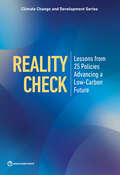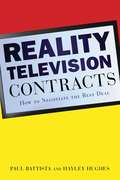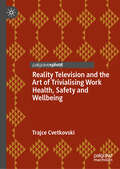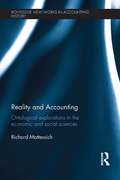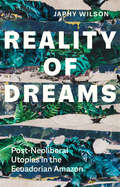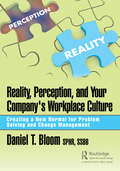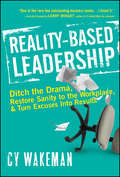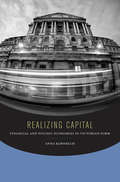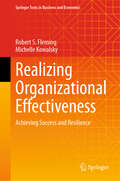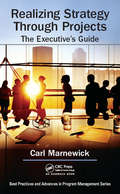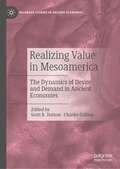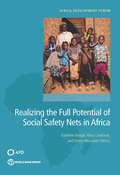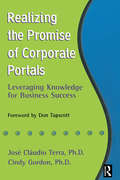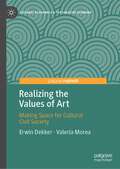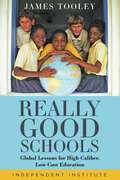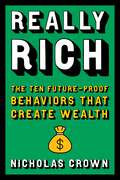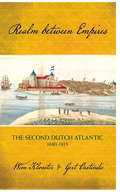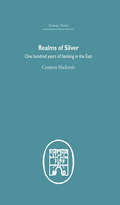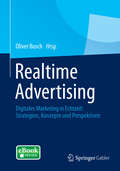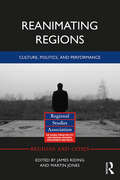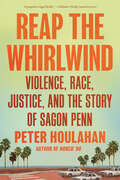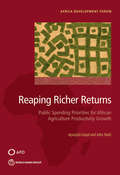- Table View
- List View
Reality Check: Lessons from 25 Policies Advancing a Low-Carbon Future (Climate Change and Development)
by The World BankTo address the myriad challenges posed by global climate change, countries at all income levels have put in place a diverse set of policies over the past three decades. Many governments have already made significant progress in their efforts to decarbonize, creating a rich history of implementation experiences that provides important lessons for how to successfully advance climate policy goals in a variety of different economic, cultural, and political contexts. Despite this progress, the transition to a net zero future continues to face significant barriers, including the need for large investment, a lack of institutional capacity, and challenging political economy issues. Reality Check: Lessons from 25 Policies Advancing a Low-Carbon Future identifies key policy approaches that countries are taking to decarbonize their economies. The report classifies policies into five categories: • Planning for a future with zero net emissions • Getting the pricing and taxes right • Facilitating and triggering transitions in key systems, such as energy and food • Getting the finance flowing, particularly by incentivizing private sector investment • Ensuring a just transition that protects the poor. Reality Check: Lessons from 25 Policies Advancing a Low-Carbon Future fills a critical research gap by documenting low-carbon policy trends and providing a series of case studies across sectors and geographies. The 25 case studies furnish country contexts and policy details, examine results and impacts, and outline key takeaways and lessons learned for enabling further ambition in achieving emissions reductions. The report contributes to an evolving analytical agenda on how to reduce carbon emissions while achieving economic development and the strategic transition to a greener, more resilient, and more inclusive future.
Reality Television Contracts: How to Negotiate the Best Deal
by Paul Battista Hayley HughesReality television is the growth area of television today. Individuals around the country want to be involved, whether in front of the camera or behind, and those who want to produce reality television seek to attract talent-maybe from the local beauty salon or perhaps the rodeo, extermination company, or trucking company-to begin taping their own "sizzle" reels to pitch to Hollywood production companies. At long last, here is a book that explains and educates those involved in reality television (and those who hope to be involved) regarding the terms found in these agreements and how best to negotiate them. This guide also includes: A brief history of reality television A breakdown of how ideas develop and of the "players" involved Reviews of and comments on agreement templates for all parties in the development and production stages "Deal point" checklists to help stay on trackDirected at attorneys who currently represent clients in the industry or would like to add reality television to their law practices, at reality television producers or those looking to break into the scene, and at all reality television participants, the contracts included in this book will be an indispensable resource all the way!Allworth Press, an imprint of Skyhorse Publishing, publishes a broad range of books on the visual and performing arts, with emphasis on the business of art. Our titles cover subjects such as graphic design, theater, branding, fine art, photography, interior design, writing, acting, film, how to start careers, business and legal forms, business practices, and more. While we don't aspire to publish a New York Times bestseller or a national bestseller, we are deeply committed to quality books that help creative professionals succeed and thrive. We often publish in areas overlooked by other publishers and welcome the author whose expertise can help our audience of readers.
Reality Television and the Art of Trivialising Work Health, Safety and Wellbeing
by Trajce CvetkovskiThis book aims to assess the extent to which work health, safety and wellbeing (HSW) considerations are trivialised on the popular Australian reality TV programme, The Block. Reality TV as a genre plays a core feature in media and cultural studies, but there has not been any research on the impact of reality TV on safety culture, or how HSW issues are portrayed in popular media. This research remedies this deficiency and demonstrates contestants are workers on The Block who perform workplace activities. The work-related activities are concerned with construction, building and renovation work; and specifically, participants engage in what are seemingly routine or ordinary everyday life activities; namely housing construction and domestic or home dwelling renovations. It supports the argument claim that contestants on reality TV are defined as workers, and this definition of worker can be extended to other genres. The book ultimately demonstrates that reality television is trivialising HSW for the purposes of satisfying audience desire to consume popular culture, and these activities perpetuate a poor image of best safety practice.
Reality and Accounting: Ontological Explorations in the Economic and Social Sciences (Routledge New Works in Accounting History #176)
by Richard MattessichThis book discusses and summarizes the revived interest in reality issues (ontology) within accounting, economics, and the information sciences, with a view to informing scholars from these different disciplines about each other’s endeavours in ontological research. Even more importantly, the book aims at familiarizing scholars from various disciplines with an evolutionary approach for examining questions about reality in the social sciences. The book is based on a partly pluralistic approach that assures unity in diversity. Unity, because all existence arises from physical reality; diversity, because emergent properties create biological and social realities that cannot be reduced to physical phenomena. Hence, the book recognizes not only concrete but also abstract entities. It shows, however, that the actualization of these abstract entities requires objectification and concrete manifestation. This pluralistic approach is central to this book. It also is a challenge to those who reject abstract entities as socially real, as well as to those who defend a non-realist position. The major task of this book is to explore proposals towards a uniform ontological basis. This uniform and universal presentation extends beyond traditional ontology (asking ‘what is real?’) to such questions as ‘on which reality level is something real?’ and ‘in which (temporal and modal) way is it real?’. Such an extended analysis) is relevant to accountants, economists, information scientists, other social scientists as well as philosophers.
Reality of Dreams: Post-Neoliberal Utopias in the Ecuadorian Amazon (Yale Agrarian Studies Series)
by Japhy WilsonAn exploration of radical megaprojects in the Ecuadorian Amazon, considering the fate of utopian fantasies under conditions of global capitalism From 2007 to 2017, the &“Citizens&’ Revolution&” launched an ambitious series of post-neoliberal megaprojects in the remote Amazonian region of Ecuador, including an interoceanic transport corridor, a world-leading biotechnology university, and a planned network of two hundred &“Millennium Cities.&” The aim was to liberate the nation from its ecologically catastrophic dependence on Amazonian oil reserves, while transforming its jungle region from a wild neoliberal frontier into a brave new world of &“twenty-first-century socialism.&” This book documents the heroic scale of this endeavor, the surreal extent of its failure, and the paradoxical process through which it ended up reinforcing the economic model that it had been designed to overcome. It explores the phantasmatic and absurd dimensions of the transformation of social reality under conditions of global capitalism, deconstructing the utopian fantasies of the state, and drawing attention to the eruption of insurgent utopias staged by those with nothing left to lose.
Reality, Perception, and Your Company's Workplace Culture: Creating a New Normal for Problem Solving and Change Management
by Daniel BloomReality and Perception and Your Company's Workplace Culture presents a demonstrable path for navigating the change-management process from beginning to end while fully detailing its obstacles and its triumphs. <P><P> The book presents the view of a fictional 100-year old company called Acme Gyroscope, which is a family owned and run business, and the reader sees how the operation was ruled with an iron hand by the outgoing CEO. When the son of this current CEO assumes the role, he finds that the processes and culture within the organization are not quite as rosy as he thought they were. The new CEO finds that there is a wide divide between what is believed and what is real. <P><P> The story follows the new CEO and his team as they uncover the problems that exist and discover solutions with the help of the Change Maestro who is an expert on understanding the difference between reality (see the problems, feel the problems, and create the new normal) and perception (preconceived notions of causes and solutions to problems). Utilizing the TLS (Theory of Constraints - Lean - Six Sigma) Continuum toolbox, the Change Maestro takes the management team through the process of resolving the issues at hand and assists in creating a new normal for corporate culture and problem solving. <P><P> Presented in ten chapters, each representing points on the critical path, it walks the reader through the change process to its conclusion reaching the final point -- the argument for the new normal corporate culture for long-term strategy and survival.
Reality, Resistance, and Resolution: How Integrative Thinkers Keep Their Options Open
by Roger L. MartinThis chapter illustrates how some business leaders have explored the tensions between opposing models of reality, and found creative solutions that go beyond trade-offs.
Reality-Based Leadership
by Larry Winget Cy WakemanLeadership strategies grounded in reality and focused on resultsRecent polls show that 71% of workers think about quitting their jobs every day. That number would be shocking-if people actually were quitting. Worse, they go to work, punching time clocks and collecting pay checks, while completely checked out emotionally. In Reality-Based Leadership, expert Fast Company blogger Cy Wakeman reveals how to be the kind of leader who changes the way people think about and perceive their circumstances-one who deals with the facts, clarifies roles, gives clear and direct feedback, and insists that everyone do the same-without drama or defensiveness. Filled with dynamic examples, innovative tools, and diagnostic tests, this book shows you how to become a Reality-Based Leader, revealing how to: Uncover destructive thought patterns with yourself and othersDiffuse drama and lead the person in front of you Stop managing and start leading, empowering others to focus on facts and think for themselvesEquipped with a facts-based, confident approach, you will free yourself from the frustrations you face at work and transform yourself into a Reality-Based Leader, with the ability to liberate and inspire others.
Realizing Capital: Financial and Psychic Economies in Victorian Form
by Anna KornbluhDuring a tumultuous period when financial speculation began rapidly to outpace industrial production and consumption, Victorian financial journalists commonly explained the instability of finance by criticizing its inherent artifice—drawing persistent attention to what they called “fictitious capital.” In a shift that naturalized this artifice, this critique of fictitious capital virtually disappeared by the 1860s, replaced by notions of fickle investor psychology and mental equilibrium encapsulated in the fascinating metaphor of “psychic economy.”In close rhetorical readings of financial journalism, political economy, and the works of Dickens, Eliot, and Trollope, Kornbluh examines the psychological framing of economics, one of the nineteenth century’s most enduring legacies, reminding us that the current dominant paradigm for understanding financial crisis has a history of its own. She shows how novels illuminate this displacement and ironize ideological metaphors linking psychology and economics, thus demonstrating literature’s unique facility for evaluating ideas in process. Inheritors of this novelistic project, Marx and Freud each advance a critique of psychic economy that refuses to naturalize capitalism.
Realizing Organizational Effectiveness: Achieving Success and Resilience (Springer Texts in Business and Economics)
by Robert S. Fleming Michelle KowalskyThis book provides graduate students and new entrepreneurs with a variety of organizational effectiveness factors that contribute to an organization’s competitive advantage, as well as its present and future success and survival. It offers leaders and employees with common understandings on how organizations work and helps them focus on efficiency rather than immediate actions based on random advice. Featuring short, accessible chapters that offer a “quick read” on important topics, this book is designed to serve as self-study reference for aspiring and current organizational leaders as well as a supplementary text for academic coursework.
Realizing Strategy through Projects: The Executive's Guide (Best Practices in Portfolio, Program, and Project Management)
by Carl MarnewickExecutives should not necessarily know the intricacies of project management, but they should know how project management, as a discipline, can benefit the organization in implementing its strategies and realizing its vision. The only way that executives can effectively apply project management to realize these goals is to have sound knowledge of the project management discipline. The purpose of this book is to provide executives with a comprehensive overview of the discipline of project management. It focuses on the benefits of project management to an organization. The goal is to provide executives with a view as to how project management can deliver organizational strategies. The various chapters focus on specific aspects within the project management discipline and how each aspect should be managed from a business perspective. The book covers the entire spectrum of project management from a management and leadership perspective. The focus is not necessarily on what needs to be done from a project management perspective, but on what organizations and senior executives can do to facilitate projects. The book covers: The value of project management Project management as a strategic enabler Project, program, and portfolio management The role of the project management office in the successful delivery of projects, programs, and portfolios The benefits of project deliverables bring Sustainability of the organization Governance and the role of the project sponsor. The book concludes with a comprehensive portfolio, program, and project management framework. This holistic framework enables organizations to achieve value from project management and realize strategic goals.
Realizing Value in Mesoamerica: The Dynamics of Desire and Demand in Ancient Economies (Palgrave Studies in Ancient Economies)
by Charles Golden Scott R. HutsonThis edited collection addresses concepts of value and its impact on economies and economic decision-making in Mesoamerica. It brings together various theoretical and methodological approaches to illuminate the little-studied topic of value in ancient economies.While scholars increasingly note that tangible objects found in the archaeological record could assume different values, depending on how they were used and circulated, less attention has been paid to how we might infer consensus (or lack of consensus) on how value was determined in past cultures so different from contemporary ones. These contributions show how multiple and conflicting understandings of what is important and meaningful coexist within any society even as moments of exchange create the impression of shared formulations of value. They consider divergences between shared understandings based on systems of beliefs and patterns of practice and the individual decisions of social actors. They also discuss how inequalities in social structures might inform our understanding of value, and how a multiplicity of values might encourage closer inspection of inequality in turn.The book brings together fifteen chapters focused on many parts of Mesoamerica, including Western Mexico, the Basin of Mexico, Veracruz, Oaxaca, and various parts of the Maya Lowlands, and range chronologically from the Classic period (250-900 CE) to the Spanish Conquest in the early 16th Century. It appeals to those working in archaeology, economic anthropology, economic history, and all those interested in how value can be understood in terms of contemporary cultural and political differences.
Realizing the Full Potential of Social Safety Nets in Africa (Africa Development Forum)
by Kathleen Beegle Aline Coudouel Emma MonsalvePoverty remains a pervasive and complex phenomenon in Sub-Saharan Africa. Part of the agenda in recent years to tackle poverty in Africa has been the launching of social safety nets programs. All countries have now deployed safety net interventions as part of their core development programs. The number of programs has skyrocketed since the mid-2000s though many programs remain limited in size. This shift in social policy reflects the progressive evolution in the understanding of the role that social safety nets can play in the fight against poverty and vulnerability, and more generally in the human capital and growth agenda. Evidence on their impacts on equity, resilience, and opportunity is growing, and makes a foundational case for investments in safety nets as a major component of national development plans. For this potential to be realized, however, safety net programs need to be significantly scaled-up. Such scaling up will involve a series of technical considerations to identify the parameters, tools, and processes that can deliver maximum benefits to the poor and vulnerable. However, in addition to technical considerations, and at least as importantly, this report argues that a series of decisive shifts need to occur in three other critical spheres: political, institutional, and fiscal. First, the political processes that shape the extent and nature of social policy need to be recognized, by stimulating political appetite for safety nets, choosing politically smart parameters, and harnessing the political impacts of safety nets to promote their sustainability. Second, the anchoring of safety net programs in institutional arrangements †“ related to the overarching policy framework for safety nets, the functions of policy and coordination, as well as program management and implementation †“ is particularly important as programs expand and are increasingly implemented through national channels. And third, in most countries, the level and predictability of resources devoted to the sector needs to increase for safety nets to reach the desired scale, through increased efficiency, increased volumes and new sources of financing, and greater ability to effectively respond to shocks. This report highlights the implications which political, institutional, and fiscal aspects have for the choice and design of programs. Fundamentally, it argues that these considerations are critical to ensure the successful scaling-up of social safety nets in Africa, and that ignoring them could lead to technically-sound, but practically impossible, choices and designs.
Realizing the Promise of Corporate Portals
by Jose Claudio Terra Cindy GordonThoughtful and provocative, 'Realizing the Promise of Corporate Portals' illustrates the vast potential of corporate portals and what your company can do to implement them for business success. Based on the authors' extensive backgrounds and consulting focused on implementing corporate portals this exciting new book extends IT theory into business strategy. Terra and Gordon explore the components and architecture of typical corporate portals and fundamental issues in knowledge management. Geared for decision makers at the executive level, this book provides a comprehensive view of the market landscape, powerful and detailed case studies, and collected best practices and lessons learned to help organizations successfully implement corporate portals. The book also includes detailed checklists necessary for selecting and implementing appropriate corporate portal technical solutions.Learn from their detailed case studies of hugely successful corporate portal implementations, including:* ADC Telecommunications Inc.* Bain & Company* Bank of Montreal* Context Integration* Eli Lilly* Hill & Knowlton* Nortel Networks* SERPRO* Siemens* Texaco * Xerox
Realizing the Values of Art: Making Space for Cultural Civil Society (Cultural Economics & the Creative Economy)
by Erwin Dekker Valeria MoreaThis book provides a novel approach to the understanding and realization of the values of art. It argues that art has often been instrumentalized for state-building, to promote social inclusion of diversity, or for economic purposes such as growth or innovation. To counteract that, the authors study the values that artists and audiences seek to realize in the social practices around the arts. They develop the concept of cultural civil society to analyze how art is practiced and values are realized in creative circles and co-creative communities of spectators. The insights are illustrated with case-studies about hip-hop, Venetian art collectives, dance festivals, science-fiction fandom, and a queer museum. The authors provide a four-stage scheme that illustrates how values are realized in a process of value orientation, imagination, realization, and evaluation.The book relies on an interdisciplinary approach rooted in economics and sociology of the arts, with an appreciation for broader social theories. It integrates these disciplines in a pragmatic approach based on the work of John Dewey and more recent neo-pragmatist work to recover the critical and constructive role that cultural civil society plays in a plural and democratic society. The authors conclude with a new perspective on cultural policy, centered around state neutrality towards the arts and aimed at creating a legal and social framework in which social practices around the arts can flourish and co-exist peacefully.
Really Good Schools: Global Lessons for High-Caliber, Low-Cost Education
by James TooleyAlmost overnight a virus has brought into question America&’s nearly 200-year-old government-run K-12 school-system—and prompted an urgent search for alternatives. But where should we turn to find them?Enter James Tooley&’s Really Good Schools. A distinguished scholar of education and the world&’s foremost expert on private, low-cost innovative education, Tooley takes readers to some of the world&’s most impoverished communities located in some of the world&’s most dangerous places—including India and such war-torn countries as Sierra Leone, Liberia, and South Sudan. There, in places where education &“experts&” fear to tread, Tooley finds thriving private schools that government, multinational NGOs, and even international charity officials deny exist. Why? Because the very existence of low-cost, high-quality private schools shatters the prevailing myth in the U.S., U.K., and western Europe that, absent government, affordable, high-quality schools for the poor could not exist. But they do. And they are ubiquitous and in high demand. Founded by unheralded, local educational entrepreneurs, these schools are proving that self-organized education is not just possible but flourishing—often enrolling far more students than &“free&” government schools do at prices within reach of even the most impoverished families. In the course of his analysis Tooley asks the key questions: What proportion of poor children is served? How good are the private schools? What are the business models for these schools? And can they be replicated and improved? The evidence is in. In poor urban and rural areas around the world, children in low-cost private schools outperform those in government schools. And the schools do so for a fraction of the per-pupil cost. Ubiquity, affordability, quality, value for money, equity, choice, and sustainability—these are the seven categories by which schooling should be judged, according to Tooley. In every instance, one is forced to conclude that low-cost, non-governmental, entrepreneurial education, as practiced by the poor around the globe, contains the key to their rise to prosperity and leadership positions within their own respective cultures. Alarmed by recent government barriers in education, Americans can now find hope in the triumph—in the face of acute adversity—of these remarkable schools. Because of the pandemic, parents in America and Europe are discovering that the education of their children is indeed possible—and likely far better—without government meddling with rigid seat-time mandates, outdated school calendars, absurd age-driven grade levels, and worse testing regimes. And having experienced the first-fruits of educational freedom, parents will be increasingly open to the possibilities of ever greater educational entrepreneurship and innovation. Thankfully, they have Really Good Schools to show the way.
Really Rich: The Ten Future-Proof Behaviors that Create Wealth
by Nicholas CrownFrom the creator of the viral series Rich vs. Really Rich, comes a modern formula for building wealth in today&’s economy that optimizes your quality of life over the amount in your bank account.Really Rich is a timely work of prescriptive finance by social media influencer and entrepreneur Nicholas Crown. Crown provides readers with an original, ten-point formula for building wealth and happiness:, including: 1. Create Value: Get rich by making someone else's life easier 2. Understand that time is priceless 3. Optimize for quality of life, not a dollar amount 4. Kindness is an accelerant to wealth Crown encourages his audience to embrace three foundational points: humility, iteration, and the world. These tools are essential for achieving your goals.
Realm between Empires: The Second Dutch Atlantic, 1680-1815
by Gert Oostindie Wim KloosterWim Klooster and Gert Oostindie present a fresh look at the Dutch Atlantic in the period following the imperial moment of the seventeenth century. This epoch (1680–1815), the authors argue, marked a distinct and significant era in which Dutch military power declined and Dutch colonies began to chart a more autonomous path.The loss of Brazil and New Netherland were twin blows to Dutch imperial pretensions. Yet the Dutch Atlantic hardly faded into insignificance. Instead, the influence of the Dutch remained, as they were increasingly drawn into the imperial systems of Britain, Spain, and France. In their synthetic and comparative history, Klooster and Oostindie reveal the fragmented identity and interconnectedness of the Dutch in three Atlantic theaters: West Africa, Guiana, and the insular Caribbean. They show that the colonies and trading posts were heterogeneous in their governance, religious profiles, and ethnic compositions and were marked by creolization. Even as colonial control weakened, the imprint of Dutch political, economic, and cultural authority would mark territories around the Atlantic for decades to come.Realm between Empires is a powerful revisionist history of the eighteenth-century Atlantic world and provides a much-needed counterpoint to the more widely known British and French Atlantic histories.
Realms of Silver: One Hundred Years of Banking in the East (International Finance Ser.)
by Compton MackenzieOriginally published in 1954 this volume looks at the difficulties encountered by the founders of the Chartered Bank of India, Australia and China in seeking, a hundred years ago, to establish the awakening countries of the East, British standard of financial probity and commercial integrity and then goes on to relate how the Bank was able to foster trade and industry in the lands to which its establishment was extended and to co-operate in the reform of archaic systems of currency.
Realtime Advertising
by Oliver BuschDieses Grundlagenwerk zu Realtime Advertising erklärt praxisnah und fundiert, welche Rolle automatisierte Echtzeit-Werbung in einem orchestrierten Media-Mix spielt und wie sie von Grund auf funktioniert. Denn: Realtime Advertising ist für Marketingverantwortliche so neu, bedrohlich und chancenreich wie die Internetwerbung zur Jahrtausendwende und selbst für viele Marketing- und Mediaexperten erklärungsbedürftig. Führende Branchenexperten aus Unternehmen, Agenturen und Medien erläutern diese revolutionäre Art des digitalen Marketings: Prof. Dr. Jürgen Seitz, Dr. Mark Grether, Aee-Ni Park, Rosa Markarian, Prof. Dr. Burkhardt Funk, Thomas Schauf, Philip Missler, Stanton Sugarman, Kate Burgarth, Stephan Noller, Marco Klimkeit, Edmund Heider, Holm Münstermann, Ingo Tenbrock, Nils Hachen, Arndt Groth, Viktor Zawadzki, Oliver Gertz, Patrick Dawson, Kolja Brosche, Sven Weisbrich, Arno Schäfer, Oliver Weiss, Alexander Gösswein, Sascha Jansen, Wolfgang Bscheid und Julian Simons. Die Autoren liefern außerdem klare Handlungsempfehlungen und handfeste Praxistipps für die begonnene Transformation des Marketings. Extra: Inklusive eBook - den Zugangs-Coupon finden Sie im Buch.
Realty Check: Real Estate Secrets for First-Time Canadian Home Buyers
by Sandra RinomatoTop advice from one of television's most well-known Realtors. Buying a home for the first time can be a daunting and stressful endeavor. The myriad questions and issues that arise can be overwhelming, resulting in an experience completely different from what first-time buyers were expecting. Sandra Rinomato, the host of the hit HGTV show Property Virgins, delivers a "realty check" by pointing buyers to homes that fit their budget, satisfy their needs, and most importantly, achieve their goal of home ownership. Realty Check covers such topics as: How to finance your home purchase without going broke. How to look past home staging and focus on the crucial elements of a potential property. Home inspection and exactly what it entails. Tips for condominium buyers. How to find and work with a good Realtor. Mortgage fraud and other legal issues. Buying a first property is a major commitment, but readers of this book will be well-prepared to take the leap into home-ownership, with their eyes wide open.
Reanimating Regions: Culture, Politics, and Performance (Regions and Cities)
by Martin Jones James RidingWriting regions, undertaking a regional study, was once a standard form of geographic communication and critique. This was until the quantitative revolution in the middle of the previous century and more definitively the critical turn in human geography towards the end of the twentieth century. From then on writing regions as they were experienced phenomenologically, or arguing culturally, historically, and politically with regions, was deemed to be old-fashioned. Yet the region is, and always will be, a central geographical concept, and thinking about regions can tell us a lot about the history of the discipline called geography. Despite taking up an identifiable place within the geographical imagination in scholarship and beyond, region remains a relatively forgotten, under-used, and in part under-theorised term. Reanimating Regions marks the continued reinvigoration of a set of disciplinary debates surrounding regions, the regional, and regional geography. Across 18 chapters from international, interdisciplinary scholars, this book writes and performs region as a temporary permanence, something held stable, not fixed and absolute, at different points in time, for different purposes. There is, as this expansive volume outlines, no single reading of a region. Reanimating Regions collectively rebalances the region within geography and geographical thought. In renewing the geography of regions as not only a site of investigation but also as an analytical framework through which to write the world, what emerges is a powerful reworking of the geographic imagination. Read against one another, the chapters weave together timely commentaries on region and regions across the globe, with a particular emphasis upon the regional as played out in the United Kingdom, and regional worlds both within and beyond Europe, offering chapters from Africa and South America. Addressing both the political and the cultural, this volume responds to the need for a consolidated and considered reflection on region, the regional, and regional geography, speaking directly to broader intellectual concerns with performance, aesthetics, identity, mobilities, the environment, and the body.
Reap the Whirlwind: Violence, Race, Justice, and the Story of Sagon Penn
by Peter HoulahanThe bestselling author of Norco &’80 returns with a riveting story of mid-1980s San Diego that placed one young Black man at the center of a whirlwind of crime and punishment that profoundly altered Southern CaliforniaMarch 31, 1985. Two white patrol officers in search of a gang member followed a pickup truck carrying seven young Black men up a dirt driveway in the Encanto neighborhood of Southeastern San Diego. Minutes later, gunshots rang out, and the truck&’s driver, Sagon Penn, fled the scene in an officer&’s patrol car. The incident stunned the city. What followed would change it forever.Penn was an idealist who believed in the power of Buddhist chants to bring about the oneness of humanity. The two police officers were rising stars in one of the most progressive police departments in the country, yet one that had suffered more officers killed in the line of duty than any other. While the facts of the case were never in dispute, what remained unresolved was what, if anything, could justify such a violent confrontation? For over two years, a determined prosecutor and a charismatic defense attorney engaged in a sensational courtroom drama that revolved around matters of mental health, racial biases, and the self-image of a once-sleepy beach town grappling with its transformation into a major metropolitan area. The Sagon Penn incident forever altered how San Diego would respond to incidents involving police and communities of color.Based on court transcripts, personal interviews, and archival police reports, Reap the Whirlwind is a gripping true-crime narrative set against the evocative backdrop of Southern California.
Reaping Returns from Community Investments: Why It Pays for Your Company to Give Back
by Jody HeymannSince members of the community often constitute a company's labor force in addition to its customer base, support from the community can facilitate both production and sales, just as opposition can significantly impede expansion. As a result, a company's relationship with the community can be a critical determinant of its economic future. This chapter shows you how your company can invest in communities during both stable and turbulent economic times. Whether you're improving the local community college or helping build much-needed infrastructure, providing transformative services to the community on any scale can greatly improve your company's public image, its employee retention rate, its performance, and its ability to expand. This chapter was originally published as Chapter 8 of "Profit at the Bottom of the Ladder: Creating Value by Investing in Your Workforce."
Reaping Richer Returns: Public Spending Priorities for African Agriculture Productivity Growth
by John Nash Aparajita GoyalEnhancing the productivity of agriculture is vital for Sub-Saharan Africa's economic future and is one of the most important tools to end extreme poverty and boost shared prosperity in the region. How governments elect to spend public resources has significant development impact in this regard. Choosing to catalyze a shift toward more effective, efficient, and climate-resilient public spending in agriculture can accelerate change and unleash growth. Not only does agricultural public spending in Sub-Saharan Africa lag behind other developing regions but its impact is vitiated by subsidy programs and transfers that tend to benefit elites to the detriment of poor people and the agricultural sector itself. Shortcomings in the budgeting processes also reduce spending effectiveness. In light of this scenario, addressing the quality of public spending and the efficiency of resource use becomes even more important than addressing only the level of spending. Improvements in the policy environment, better institutions, and investments in rural public goods positively affect agricultural productivity. These, combined with smarter use of public funds, have helped lay the foundations for agricultural productivity growth around the world, resulting in a wealth of important lessons from which African policy makers and development practitioners can draw. 'Reaping Richer Returns: Public Spending Priorities for African Agriculture Productivity Growth' will be of particular interest to policy makers, development practitioners, and academics. The rigorous analysis presented in this book provides options for reform with a view to boosting the productivity of African agriculture and eventually increasing development impact.
